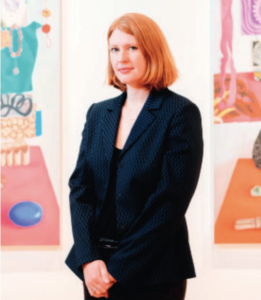State of the Art
With a wave of high-profile art galleries relocating to its chic and spacious lofts, Manhattan’s Tribeca neighborhood is quickly regaining its status as New York City’s art gallery hub. Hand in hand with this urban renewal are female dealers representing a slew of women artists and artists of color
By Jasmine P Ting
Photography Katelyn Perry
THE OPENING NIGHT OF AN ART EXHIBITION IN NEW YORK IS ALWAYS SOMETHING TO BEHOLD.
. . .
ANOTHER GALLERIST JOINING THE
Tribeca art rush is Elizabeth Denny, who opened Denny Dimin Gallery together with her business partner, Robert Dimin, in 2019 in the same building as Monica King Contemporary. Denny moved from her Lower East Side location for a practical reason: more space.
“It was almost as if we had only one room to exhibit, show work, work at a desk and also pack and ship for all these art fairs all over the world,” says Denny, whose new space includes an office and a basement.
During my visit, a strikingly large pink circus tent with hand-painted horses and eyes was on display in the front gallery. It beckoned visitors to take their shoes off and enter, where a video depicting herding culture and Shamanism – a gentle nudge for viewers to reflect on climate change – played on loop.
The installation was part of Dana Sherwood’s “Horses for the Trees” exhibition. “We hung on to the Lower East Side space for as long as we could, because getting bigger, more expensive real estate in New York is always a risk,” Denny shares. “But eventually we had to go, and we were really happy that the Tribeca thing was starting at the same time.” The thirtysomething gallery owner uses her platform to promote a diverse set of artists with relevant messages to tell – especially women. This roster includes Sherwood, Amir H Fallah, Lau Wai and more.

In retrospect, Denny realized that female artists were hardly ever studied in her art history classes at the Courtauld Institute of Art at the University of London. “From the beginning, I was already in an environment where only males were the valued producers and I actually never really questioned it because there was no space to question it,” Denny recalls.
“I think that it’s better now. I think there are art historians trying to find some of the untold stories, and we’ve had exhibitions on artists like Hilma af Klint, and things like that that are kind of trying to go back and find the women producers,” she adds. The gallery’s 2020 schedule continues Denny’s vision.
In January, it presented an exhibition by queer feminist artist Clarity Haynes, and a show by Sean Fader on the past two decades of queer history is lined up as well. “In the later part of the year, we will have solo exhibitions by important female artists in the gallery program – Justine Hill in New York and Amanda Valdez in Hong Kong,” Denny says.
. . .
